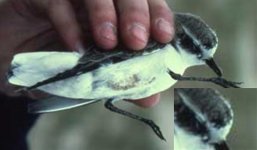To help play the home version of the game:
…lumped in the 19th Supplement (first Supplement since the Check-List) in 1944 (Auk 61:441-464).
http://elibrary.unm.edu/sora/Auk/v061n03/p0441-p0464a.pdf .
104 Charadrius nivosus nivosus and C. n. tenuirostris become Charadrius alexan-
drinus nivosus and Charadrius alexandrinus tenuirostris, as they are con-
sidered races of the Old World bird. See Peters, Check-list, 2, 1934, 250.
Charadrius nivosus (Cass.).
The bird described by Cassin as Aegialitis nivosa has by most recent authors been considered a distinct species. It is very similar in general appearance to Charadrius alexandrinus alexandrinus (Linnaeus), but differs chiefly in having the lores wholly white (instead of with a black line from the eye to the bill), and the rufous of the pileurn less pronounced in fully adult plumage. Examination of a large series of birds of this species shows, however, that the characters distinguishing these two forms are not constant. That of the rufous of the head is too changeable to be of much value
in the determination of specimens, so that the color of the lores is much the best character. But even this varies to such an extent that it is impossible to find any definite llne of demarcation between the two forms. Specimens of the American Charadrius nivosus occur with partly black lores, and of the Old World Charadrius
alexandrinus with nearly white lores. In view of these facts, it is of course, inadvisable to maintain the specific distinction of Charadrius nivosus. It, therefore, should be regarded as a subspecies of Charadrius alexandrinus. It is interesting to note that this is the view taken many years ago by Mr. Henry Seebohm, as well as by some recent authors. Mr. Ridgway has recently separated the American birds into two races; so that our Snowy Plovers should now stand as Charadrius alexandrinus nivosus
(Cassin), and Charadrius alexandrinus tenuirostris (Lawrence).
1 Rep. Explor. and Surv. R. R. Pac., IX, 1858, p. 696 (Presidio, near San
Francisco, California).
2 Geographical Distribution of the Charadriidae, 1887, p. 171.
3 Bull. U.S. Nat. Mus., No. 50, part VIII, 1919, pp. 136-140
Leucopolius alexandrinus nivosus (Cassin) becomes Charadrius
nivosus nivosus (Cassin), because specifically different from Cha-
radrius nivosus, and not generically distinct from Charadrius. (Cf.
Ridgway, Bull. U.S. Nat. Mus., No. 50, VIII, June 26, 1919, pp.
136-137.)
Charadrius nivosus tenuirostris (Lawrence). Aegialitis tenuirostris
Lawrence, Ann. Lyc. Nat. Hist. N.Y., VII, 1862, p. 455 (near Guan-
tanamo, Cuba). Revived as a subspecies. (Cf. Ridgway, Bull.
U.S. Nat. Mus., No. 50, VIII, June 26, 1919, p. 139.) Range:
southeastern United States, south in winter to Paraguay.
FIFTH ANNUAL LIST OF PROPOSED CHANGES IN THE
A. O. U. CHECK-LIST OF NORTH AMERICAN BIRDS.
BY HARRY C. OBERHOLSER. Auk April 1920.
Peters Birds of the World v. 2
http://www.biodiversitylibrary.org/item/50592#page/272/mode/1up .
Linnaeus, C. 1758. Systema naturae per regna tria naturae: secundum classes, ordines, genera, species, cum characteribus, differentiis, synonymis, locis. 10th edition.
http://www.biodiversitylibrary.org/item/10277#page/169/mode/1up .
Charadrius alexandrinus habitat ad Aegypteus ex Nilo canalem.
He takes the name from Hasselquist. The Kent Plover name comes from a Latham name from 1790 (Charadrius cantianus), so the vernacular name should be either Alexandrian Plover, Nile Channel Plover, or Hasselquist’s Plover. Charadrius alexandrinus m. The Alexandrian Dotterell. IT is of the size of a Lark: I found it the 24th of May, 1750, in the channel, which leads the water of the Nile to Alexandria. It feeds on insects.
http://books.google.com/books?pg=PA...Zwd2_Cw&ct=result&id=8lFCAAAAcAAJ&output=text .
…tenuirostris
http://books.google.com/books?id=Vg...&resnum=2&ved=0CB4Q6AEwAQ#v=onepage&q&f=false .
p. 455.
His first visit to the rich collecting grounds about Guantanamo was in June, 1858, when he lived six weeks at the railway station at Caimanera on Guantanamo Bay, where he collected along its shores. Having found in July, on one of the immense sand flats of that region, a nesting Snowy Plover, Aegialitis nivosa (Cassin) with a set of three eggs, he took the mother alive in a bird-net, sending her to Mr. Lawrence, who described it as Aegialitis tenuirostris (Law.), but Dr. Ridgway later determined the species to be A. nivosa (Cass.).
Occidentalis
Charadrius nivosus occidentalis (Cabanis) 1872 J.Orn. 20 no.116 p.158 .
I think occidentalis came from Peru? Chile? Not a “North American subspecies”.
Charadrius marginatus Vieillot 1818 Nouv.Dict.Hist.Nat. 27 p.138 .
In this Vieillot says Charadrius marginatus is from Geoffrey de Saint-Hilaire. Zoonomen has this from the Dictionary not Ornithologie
http://books.google.com/books?q=editions:LCCN06002713&lr=&id=_1JhAAAAIAAJ&sa=N&start=40 . Volume 27 p. 138.
Measurements of C. alexandrinus (Charadrius alexandrinus Linnaeus; C. cantianut Latham) are given for comparison, this being the Old World representative of C. nivosus. Besides having longer wings, relatively shorter tail, and decidedly longer tarsi and toes than C. nivosus, C. alexandrinus has a black loral stripe and other differences of coloration.
Ridgway 1919
The birds of North and middle America
http://books.google.com/books?print...&pg=PA137&id=5ooaAAAAYAAJ#v=onepage&q&f=false .
“With a decent sample of published sonograms, I would instantly change to a YES vote,” Someone needs to get to work.






